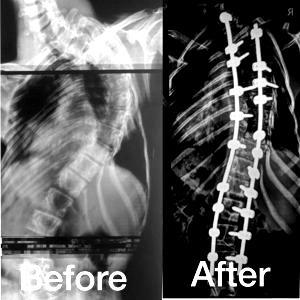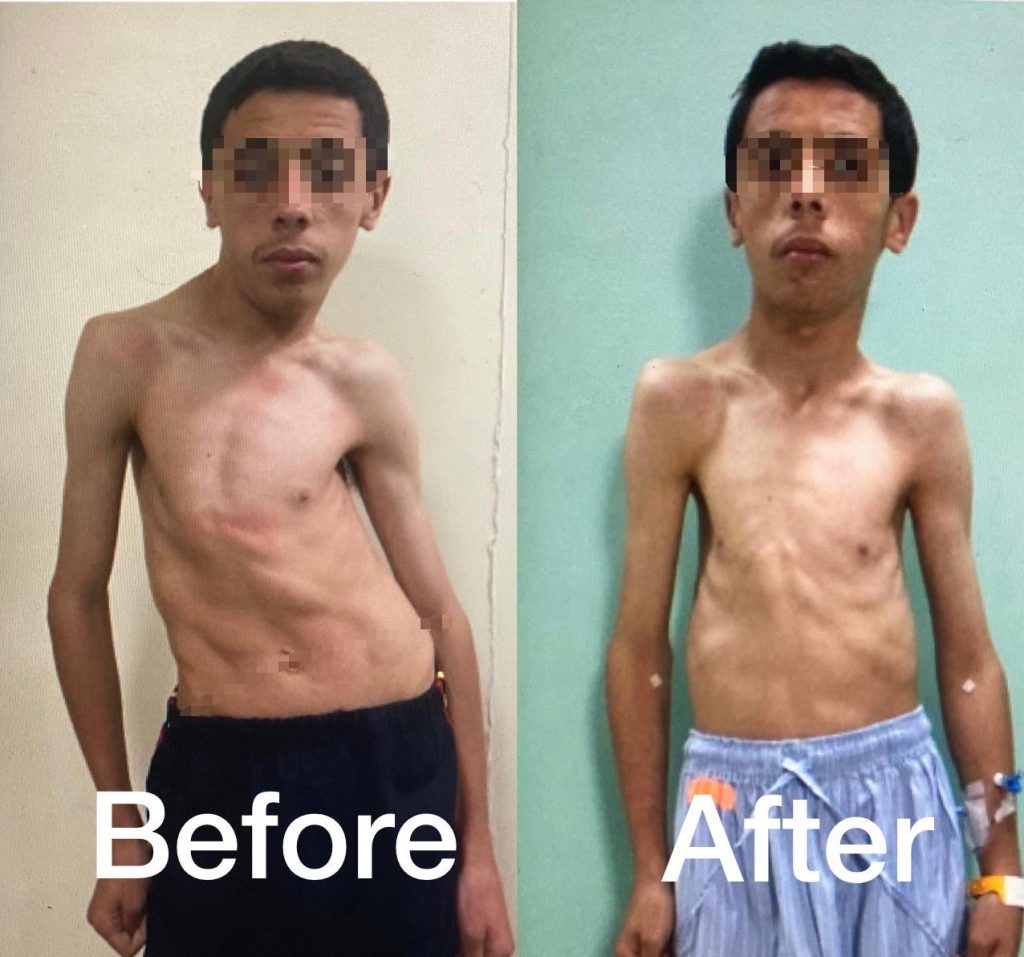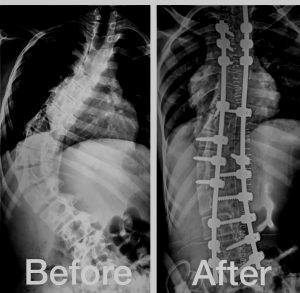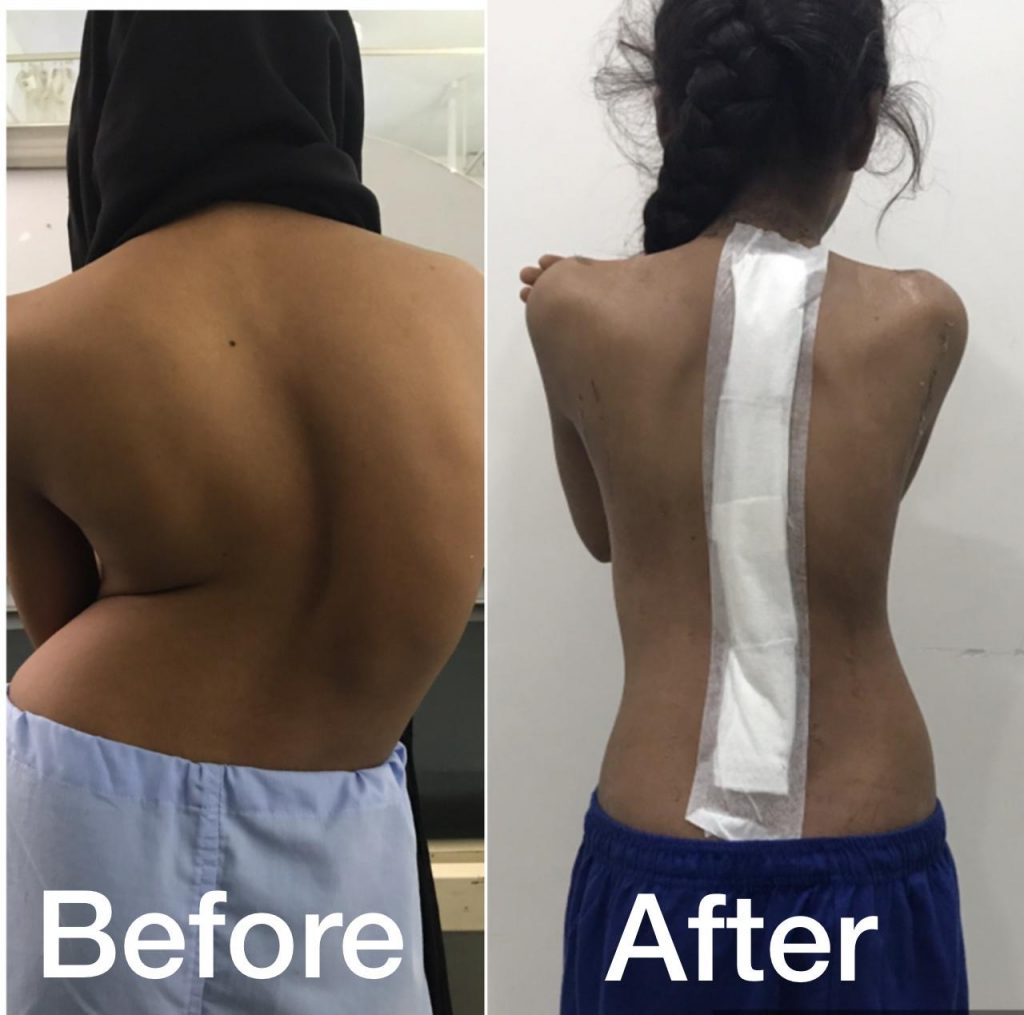Scoliosis treatment in Mumbai
Scoliosis: Diagnosis and treatment
Spinal Diseases
Back pain
Neck Pain
Slip Disc
Spinal Stenosis
Spondylosis
Spondylolisthesis
Cervical Myelopathy
Spine Fracture
Spine Tuberculosis
Spinal Tumors
Scoliosis
Kyphosis
Dr. Amit Sharma is renowned as the best scoliosis doctor in Mumbai, backed by years of experience, a dedication to patient care, and a track record of successful scoliosis treatments. His commitment to improving the lives of patients dealing with spinal deformities is widely recognized, making him the trusted choice for scoliosis care in the city.
Spine need to be in particular alignment for proper body posture and balance. If seen from behind, spine has to be in a straight line. A sideway curvature of the spine is called Scoliosis. Scoliosis is primarily classified based on the location of maximum spine deformity: Cervical Scoliosis, Thoracic Scoliosis, Lumbar Scoliosis. Scoliosis is primarily a problem of developing skeletal system; however, it can affect adult spine also.
Causes of Scoliosis:
- Idiopathic Scoliosis :The cause behind majority of scoliosis is unknown. Majority of scoliosis patients belong to this category. Girls are affected more than boys. Idiopathic Scoliosis also have genetic component and can run in family.
- Congenital Scoliosis: Some patients have bony abnormality within the vertebrae, which can lead to abnormal curvature. These curves are usually acute and progress rapidly.
- Neuromuscular Scoliosis: Loss of muscle support to spine due to inherent problems in muscles or lack of muscle coordination from brain/ nerve problems can also cause scoliosis. There are usually long “C” shaped curves.
- Degenerative Scoliosis: Adult patients may have unequal degeneration of vertebral segment leading to curvature of the spine.
- Secondary Scoliosis: Scoliosis can also be due to uneven destruction of bone by spine infection/ spine fracture/ spinal tumors etc., e.g. Osteoid Osteoma.
- Syndromic Scoliosis: Various systemic diseases (genetic/ nongenetic) have associates spine deformity, e.g. Marfan Syndrome, Down’s Syndrome, Osteogenesis Imperfecta, Neurofibromatosis etc.
- Unequal leg length with pelvic obliquity, muscle spasm, slip disc, and rarely psychosomatic issues can also lead to scoliotic curvature of the spine.
Scoliosis can also be classified based on the age when spine deformity is first noticed by patient:
- Early Onset Scoliosis: Age less than 10 years,
- Late Onset Scoliosis: more than 10 years to completion of bone growth (16-18 years),
- Adult Onset Scoliosis: After bone growth is completed (age more than 18 years).
These classifications help spine specialist decide correct treatment.
Symptoms of Scoliosis:
Primary symptom of scoliosis is cosmetic spine deformity. Along with abnormal curvature of spine, patient also have chest wall deformity, rib hump, lumbar muscle prominence, shoulder height inequality, asymmetric waist, unequal breast prominence (due to chest wall deformity) depending upon site and severity of the spine deformity. Patient’s body might be tilted to one side. In severe and Neuromuscular cases, patients might have difficulty in sitting, standing, and walking.
Many patients present with back pain, especially with degenerative scoliosis, due to associated degenerative changes in the vertebral joints. Even Idiopathic Scoliosis cause back pain due to unequal loading of muscles. Patients with Neuromuscular Scoliosis will have features of associated nerve/ muscle anomaly. A Congenital Scoliosis usually have acute curve, which is cosmetically more disfiguring.
Spinal cord compression might happen with severe deformity, especially in Congenital and Degenerative Scoliosis. This might lead to symptoms of spinal stenosis (loss of sensation and weakness in arms/ legs, loss of bladder-bowel control, loss of dexterity and weakness in hand grip, loss of balance and spasticity in legs). Congenital Scoliosis is usually associated with intra-spinal anomalies like Tethered Cord, Diastematomyelia etc. Spinal cord might also have abnormality in some cases of Idiopathic Scoliosis. Associated features of primary cause will be present in Neuromuscular and Secondary Scoliosis.
Early onset severe scoliosis can significantly affect growth of lung volume and also affect heart functioning in addition to causing short stature. Congenital Scoliosis is usually associated with various heart, kidney and abdominal anomalies.
Diagnosis of Scoliosis:
A thorough history and physical examination is required to assess magnitude of deformity and ascertain possible cause of scoliosis. A detailed neurological examination is must to rule out spinal cord involvement. Patient’s primary complaint need to be understood (concern about future worsening, cosmetic problem, difficulty in sitting-standing, back pain, neurological symptoms). Signs of puberty (Secondary sexual characteristics) are noted to determine remaining growth. Specific examination to identify features of associated anomalies in Neuromuscular, Congenital and Secondary Scoliosis is done.
Following tests are required:
X-ray: X-ray is first and most important diagnostic tool. It will show magnitude of the curve. X-ray can be repeated at regular intervals to assess worsening of the curve for patients who are under observation. Sideway bending x-rays will reveal flexibility of the spine deformity and will help spine specialist choose correct surgical procedure.
MRI Scan: MRI is compulsory in every patient with scoliosis due to high incidence of associated spinal cord problems (even with Idiopathic Scoliosis). MRI will also reveal spinal cord and bone anomalies in Congenital and Secondary Scoliosis. MRI will show spinal stenosis and degenerative changes in Degenerative Scoliosis.
CT Scan: A CT is required whenever a detailed assessment of bone anatomy is required, as in Congenital Scoliosis and Spinal Fractures/ Spinal Infections. A 3D reconstruction of spinal model is very helpful in planning spine deformity surgery. CT will also help in choosing the best method of instrumentation for a given pathology.
EMG NCV: To assess abnormal nerve function.
Other Tests: USG abdomen and cardiac 2D Echo are required to rule out other congenital anomalies (Congenital Scoliosis). A biopsy might be required to rule out spinal tumors/ spinal infections is suspected cases.




Treatment of Scoliosis:
Best treatment for scoliosis varies from patient to patient and is based on age at presentation, type of scoliosis, severity of the curve etc. It can be divided in three broad categories:
- Observation: Patients are kept under observation if:
- Deformity is not severe requiring immediate bracing or surgery,
- Cosmetic disfigurement is not significant,
- There are no neurological problems,
- Treatment by bracing/ surgery is not possible (very young age, debilitated patients, associated medical problems etc.)
It is very important to keep a close eye on every patient presenting with spinal deformity for following reasons-
-
- A young patient has high chance of progression of spinal deformity due to remaining growth spurts and long period remaining for growth.
- Congenital and Neuromuscular Scoliosis as they have high chances of progression,
- Patients with borderline scoliosis, to prevent their progression in surgical category, and to detect and treat early if they progress,
- Case with high risk of developing neurological problems, e.g. congenital scoliosis, certain secondary scoliosis.
These patients require regular follow up every 3-4 months to assess worsening of deformity by clinical and x-ray examination.
- Bracing/ Casting: Patients with borderline scoliosis with Cobb Angle in the range of 20-40 degrees are best treated by a cast (patients below 5 years) or brace. The aim of casting/ bracing is to 1) prevent further progression of the curve to possibly avoid surgery, 2) To postpone the surgery to allow development of lungs in very young patients and to allow trunk growth to achieve better height before spinal fusion surgery takes place. Bracing will not work for patient who have attained skeletal maturity. Bracing has no role for the curves beyond 40 degrees. Bracing does not reverse the curve.
- A regular follow up with clinical examination and x-ray is essential during bracing period to check for progression of the spinal deformity requiring change in bracing or possible need of spine surgery. Brace might need to be changed several times during the treatment to adjust for growth of the body. Bracing is not useful for congenital, neuromuscular, and degenerative scoliosis.
- Surgery (Deformity correction, instrumentation and fusion): Surgical correction is best treatment for scoliosis in following situations:
- High magnitude curves (> 40 degrees),
- Curves showing progression despite bracing/ casting,
- Cosmetic disfigurement due to significant curve,
- Scoliotic curves with body imbalance,
- Curves with impending/ associated neurological symptoms.
- Congenital and Neuromuscular Scoliosis as they have high likelihood of progression.
Idiopathic Scoliosis: Primary aim of surgery in scoliosis is to prevent worsening of the curve and to get as much correction as possible safely. Various surgical techniques are available. Most commonly, a posterior approach is used. Spinal segments in the curve are aligned and fused with the help of instrumentation. It is aimed to keep instrumentation level to minimum as instrumented part of the spine will lose its movements causing spinal stiffness. In certain cases, an anterior surgery is required to loosen a rigid deformity to achieve better correction by posterior surgery. Sometimes, an anterior only spine surgery can be done which provides better scar and saves some motion segments.
Various motion preserving scoliosis surgeries are also available. In these surgeries, curve correction is done with flexible devices without fusion. They are suited for flexible curves of lesser magnitude.
It is advisable to get surgery done as soon as possible once the curve has crossed 40-50 degrees. Curves with higher magnitude are difficult to correct, are usually only partially correctible with unsatisfactory cosmetic results, and have high complication rate.
Early onset scoliosis: Various non-fusion instrumentation surgeries are done to correct the curve to allow chest expansion and lung growth. These devices act as internal brace and prevent rapid progression of the deformity. A fusion surgery is then done around the age of 10 years to allow lung development and achieve a better height.
Congenital Scoliosis: An early surgery is advised as these curves progress rapidly. They carry higher risk of nerve related problems when surgically corrected due to acute curve and associated spinal cord anomalies. These risks increases if curve is severe.
Neuromuscular Scoliosis: An early surgery is advised as these curves also progress rapidly. Patient usually have associated sitting imbalance and nutritional difficulties due to deformity.
Degenerative Scoliosis: These patients have symptoms of degenerative spinal changes (back pain, nerve pressure related symptoms) along with spinal deformity. Surgical correction usually involves an extensive surgery to correct the deformity and to treat degenerative changes by spinal decompression/ fusion. Anterior surgery is required many times to provide support and to achieve better fusion. These surgeries carry a high complication rate, both during and after the surgery. Also, recovery process from these extensive surgeries can be complicated due to associated medical illnesses in these elderly patients.
A high incidence of implant failure (screws loosening, screw-rod breakage etc.) is also noted in these patients due to osteoporosis and poor healing capacity. All risks and benefits need to be carefully assessed before making a decision to proceed with surgery for these patients. Occasionally, a smaller magnitude surgery targeting the most symptomatic pathology can be done (e.g. one or 2 level decompression/ instrumentation) to provide best symptomatic relief to the patient without doing an extensive surgery.
There is no proven benefit of exercise/ physiotherapy in correcting scoliosis. Supportive treatment like physiotherapy, epidural injections etc. can be done as per the symptomatic requirement of the patient.
Complications of Scoliosis Surgery:
- Inadequate correction: Higher magnitude curve are difficult to correct. An attempt at complete and forceful correction will make surgery extensive and risky as it can affect spinal cord. It is not necessary to correct the curve completely to provide desired cosmetic results.
- Neurological Problems: The amount of risk depends on the patient’s age, the degree of curve, the cause of the curve, and the amount of correction attempted. Scoliosis with severe curves and congenital scoliosis have higher risk. Neuro-monitoring helps prevent these complications.
- Implant related problems: Implants may become prominent in young patients due to lack of sufficient fat/ muscle cover. There is high incidence of implant failure in non-fusion instrumentation surgeries due to continuous stress on implants by spine movements. A failed fusion may cause implant loosening or break in instrumentation/ fusion surgeries. Misplaced implants may irritate spinal cord/ spinal nerves.
- Other risks: Usual risk of any surgery, e.g. infection, pain etc. are similar to other surgeries and are taken care of with appropriate medicines.
Latest Advances in Scoliosis Surgery:
- Computer Navigation/ Robotic Surgery: Vertebrae are rotated and deformed in scoliosis. Smaller bones in children are difficult to instrument. Use of navigation techniques allow intra-operative guidance about screw placement for better hold and to prevent complications related to misplaced implants.
- Neuromonitoring: Intra-operative assessment of spinal cord function is possible by neuromonitoring. Neuromonitoring gives continuous feedback to spine surgeon during surgery about function of spinal cord and spinal nerves. If any step causes changes in nerve function, it can be immediately reversed by the surgeon.
- Motion Preserving Correction: Various instrumentation devices are available which corrects the deformity without spinal fusion. This saves movements at instrumented levels and prevent back stiffness. However, these devices cannot treat severe curves. Also, their failure rate is high due to ongoing spine movement which puts continuous stress on these implants.
- Others: Other advances to prevent excessive blood loss during surgery and to reutilize the blood lost during the surgery to avoid the need of transfusion (cell-saver) are available.
Recovery after scoliosis surgery is fairly quick. Patients are allowed to sit and walk very next day after the surgery depending upon their pain tolerance. Advanced pain management protocols help minimize the pain during recovery.
https://youtu.be/VLyYQDSMRh4
Frequently asked questions:
What is scoliosis, and how is it diagnosed?
Scoliosis is a sideways curvature of the spine. It can be diagnosed through a physical examination, X-rays, and sometimes additional imaging tests like MRIs.
Is there a specialist for scoliosis in Mumbai?
Yes, Mumbai has highly experienced specialists who focus on scoliosis treatment and care, such as Dr. Amit Sharma, renowned as the best scoliosis doctor in Mumbai.
What is the treatment for scoliosis in Mumbai?
Treatment options include non-surgical approaches like bracing and physiotherapy, as well as surgical interventions when necessary, performed by top scoliosis surgeons in Mumbai.
Can adults get scoliosis treatment in Mumbai?
Absolutely, adults with scoliosis can receive specialized treatment in Mumbai, including non-surgical management and surgical options tailored to their needs.
Is pediatric scoliosis treated differently in Mumbai?
Yes, pediatric scoliosis requires specialized care in Mumbai, often involving a multidisciplinary team of experts for comprehensive treatment and monitoring.
What is adolescent idiopathic scoliosis (AIS), and how is it treated in Mumbai?
AIS is a common form of scoliosis in adolescents. It is treated through a combination of bracing, physiotherapy, and close monitoring by scoliosis specialists in Mumbai.
Can scoliosis cause back pain, and how is it managed in Mumbai?
Scoliosis can lead to back pain. Management includes pain relief methods and, if necessary, surgical interventions performed by top scoliosis surgeons in Mumbai.
Are scoliosis screening programs available in Mumbai?
Yes, scoliosis screening programs are conducted in Mumbai to detect spinal curvature in children and adolescents at an early stage.
What is congenital scoliosis, and how is it treated in Mumbai?
Congenital scoliosis is present at birth. Treatment options depend on its severity and often involve a combination of bracing, physiotherapy, and surgery in Mumbai.
Is scoliosis surgery available in Mumbai, and who are the top scoliosis surgeons in the city?
Yes, Mumbai offers state-of-the-art scoliosis surgery performed by top-rated scoliosis surgeons like Dr. Amit Sharma, who is known for exceptional expertise in scoliosis care.
